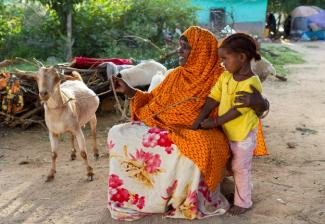Africa’s drylands are vibrant centers of livestock trade and mobility, rich in natural resources, culture and biological diversity, with populations renowned for their ability to survive in harsh environments. Despite their adaptability, worsening conditions have challenged even their survival skills. While we cannot stop natural disasters, USAID is supporting people and systems to withstand them. USAID and its partners have been at the forefront of enhancing the resilience of people living in areas of chronic shock – especially the dry lands of the Horn of Africa.
Our efforts contribute to reduced vulnerability and more inclusive economic growth. Our programs increase adaptability to recurrent shocks such as drought, conflict, and natural disasters, while reducing the risk of humanitarian crises and improving the social and economic conditions of vulnerable populations. Our programs foster interventions that enhance integration of humanitarian-development-peace nexus towards resilience building, inclusive economic growth, and locally led development. We help communities transition from being recipients of emergency relief to having the capacity to prepare for and recover from shocks, such as drought.
To achieve these goals, we work closely with national governments, development partners, and regional bodies, such as the Intergovernmental Authority on Development (IGAD), with a renewed emphasis on building resilience, climate adaptation, fostering self-reliance and delivering on regions development trajectories as prioritized by local institutions. USAID established the Horn of Africa Resilience Network (HoRN) to work across missions and partners to strengthen regional and cross-border collaboration and improve evidence-based learning.
EAST AFRICA
USAID supports resilience building in the region and reducing the need for humanitarian assistance, particularly the cross-border areas that have historically suffered from underinvestment and whose challenges and vulnerabilities cannot be tackled by national action alone. We focus our regional programs on supporting locally-led development through strengthening the capacity of local institutions that are best placed to define sustainable local solutions to local problems and ensure local ownership.
We work to strengthen social cohesion to address conflicts that have been a major obstacle in the region. We work to expand livelihoods, strengthen market systems, and enhance employment opportunities, especially for women, youth, and traditionally marginalized groups.
There are many complex factors that underpin economic development in the region. We also work to provide the equitable sharing of natural resources in cross-border areas, to strengthen resilience measurement frameworks to track the number of people transitioning off humanitarian assistance, and shed light on food insecurity, poverty, and malnutrition. The program also brings together development and relief actors and resources to promote alignment, coordination, and harmonization of efforts through platforms like Global Alliance for Action for Drought Resilience and Growth Resilience.
In order to use data and best practices for decision making, we are strengthening platforms for collaboration and learning between the civil society, private sector, and local government to advance shared interests that build resilience, mitigate conflict, increase economic opportunities, and enhance inclusive decision making to redress power imbalances. Our regional learning initiative promotes communities of learning and collaboration for improved resilience programming and pro-resilience policies, bringing together bilateral and regional partners to share lessons learned and advance innovation on resilience in East Africa.
USAID initiatives complement regional resilience strategies developed by regional partners like IGAD, who continue to drive the resilience agenda in the region under IGAD Drought Disaster Resilience and Sustainability framework. USAID also explores innovative ways of diversifying these partnerships to include the private sector and civil society organizations to advance capacity and commitment for the Journey to Self-Reliance in the region.
Below is our regional resilience focus zones:

Fact sheets
Cross-Border Community Resilience Project
Horn of Africa Resilience Network (HoRN)

USAID/EA
